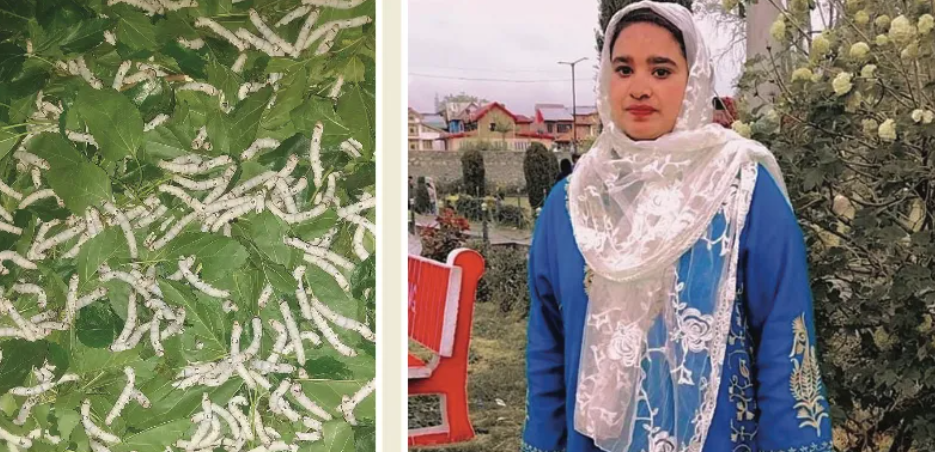Ruqaya earns a decent livelihood by rearing silkworms

A young woman’s entrepreneurial spirit captivated a Sher-e-Kashmir International Convention Centre (SKICC) audience. On August 10, 21-year-old Ruqaya Jan took centre stage, standing confidently behind a wooden lectern to share her inspiring journey in agri-entrepreneurship. As she spoke, her words were met with enthusiastic applause, a testament to the impact of her story and the promise of her venture.
This pivotal moment unfolded at an event organised by the Agriculture Production Department, designed to showcase the success stories emerging from the Holistic Agriculture Development Programme (HADP). The HADP, a forward-thinking initiative aimed at fostering sustainable agricultural practices in the region, has become a catalyst for change in the lives of many, including Ruqaya.
The gathering served a dual purpose: not only did it provide a platform for beneficiaries like Ruqaya to share their experiences, but it also facilitated valuable interactions between these emerging entrepreneurs and key stakeholders in the agricultural sector. As Ruqaya’s brief yet powerful speech resonated through the convention centre, it became clear that her journey was more than just a personal success story – it was a beacon of hope and a model for sustainable development in the region.
The audience’s warm reception and encouragement underscored the potential of Ruqaya’s initiative, hinting at the possibility of scaling her venture to new heights.
Jan’s journey began in 2021 when she set up a silkworm-rearing unit in Lalpora, a small, nondescript village in the Tral area of south Kashmir, some 47 kms from Srinagar.
“It was a tough time when I decided to start this initiative as the entire world was caught in the throes of COVID-19,” said Jan.
Driven by the need to support her family’s income and help her father, who does menial jobs at construction sites, Jan decided to pursue entrepreneurship in agriculture—a sector known for its challenges and rich dividends. Availing benefits under the HADP programme, Jan began rearing the silkworms.
She placed the worms in some plastic trays inside a newly built spacious shed and fed these small creatures with mulberry leaves, their primary diet, under the ideal conditions necessary for their growth.
“Initially, I was able to produce only a few kilograms of cocoons which fetched me a good amount,” said Jan, sharing her journey with Greater Kashmir.
Emboldened by the financial gains, her unit produced 70 to 80 kgs of cocoons next year, which fetched her around Rs 90,000 to Rs 1,00,000.
“I began rearing worms twice a year – first in May and June and then again in July and August”, Jan said. She said that now she was intending to rear them thrice in a year with technical and financial assistance provided by the Department of Sericulture.
Jan’s success story not only highlights the potential of agri-entrepreneurship in transforming lives but also serves as an inspiration for others, particularly women, to explore opportunities in this sector. In 2023, the Jammu and Kashmir government launched a Rs 91 crore initiative aimed at reviving the silk industry through a series of strategic measures.
In addition to installing an Automatic Reeling Machine (ARM) in Jammu, the project prioritized boosting cocoon production and improving the skills of farmers involved in the industry. In 2022–2023, Jammu and Kashmir produced 699 million tons (MT) of cocoons, and in the current year, 800 MT. The department provided 23.745 lakh disease-free layings (DFLs) to cocoon growers in Jammu and Kashmir last year. Likewise, farmers now receive Rs 1.25 lakh to Rs 1.75 lakh more in funding to build the infrastructure for rearing units.
Official statistics show that 27,000 families in Jammu and Kashmir are engaged in sericulture. A total of 336.73 hectares are covered by 146 mulberry nurseries. The goal of the Jammu and Kashmir government’s concerted efforts is to bring the region’s silk industry back to its previous level of importance.
In addition to strengthening the local economy, the revitalization seeks to protect and advance a rich cultural legacy that has long contributed to the region’s identity.
Article Credit: greaterkashmir